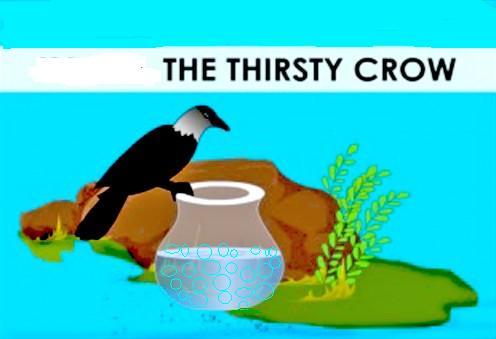As the Crow Fills
 Once, a very thirsty crow searched for water everywhere. At last he saw
a pot with but very little water in it. He put his beak inside. Alas, he could not reach down to the water level. The shrewd crow then thought of a plan. He picked some pebbles and dropped them one by one into the pot. The water level started rising till it came right up to the brim. The crow drank the water and congratulated itself for being clever.
We’ve always known this story since we were little children, haven’t we?
Now for the mathematics of the situation: Suppose the pot was fashioned with a hemisphere d= 40 cm and a truncated cone (base circle diameter of 40 cm and top circle diameter of 14 cm with a height of 14 cm). If the crow selected perfect spherical pebbles of 1 cm diameter i.e. quite small as compared to the pot size for filling the pot, what should have been the minimum level of water (in cms correct to 3 decimal places) initially in the spheri-conical pot if the crow did not go thirsty?
Once, a very thirsty crow searched for water everywhere. At last he saw
a pot with but very little water in it. He put his beak inside. Alas, he could not reach down to the water level. The shrewd crow then thought of a plan. He picked some pebbles and dropped them one by one into the pot. The water level started rising till it came right up to the brim. The crow drank the water and congratulated itself for being clever.
We’ve always known this story since we were little children, haven’t we?
Now for the mathematics of the situation: Suppose the pot was fashioned with a hemisphere d= 40 cm and a truncated cone (base circle diameter of 40 cm and top circle diameter of 14 cm with a height of 14 cm). If the crow selected perfect spherical pebbles of 1 cm diameter i.e. quite small as compared to the pot size for filling the pot, what should have been the minimum level of water (in cms correct to 3 decimal places) initially in the spheri-conical pot if the crow did not go thirsty?
Problem from Mindsport by Mukul Sharma
The answer is 11.356.
This section requires Javascript.
You are seeing this because something didn't load right. We suggest you, (a) try
refreshing the page, (b) enabling javascript if it is disabled on your browser and,
finally, (c)
loading the
non-javascript version of this page
. We're sorry about the hassle.
Given: r =7, R=20, h=14, Volume of truncated cone= V = π × h × (R²+r²+R×r)/ 3 = 8635.19 cm³ With R=20, Volume of hemi-sphere = 2 π R³/3 = 16755.2 cm³ Volume of the spheri-conical container ~ 25390.39 cm³ and the empty space within after the spherical pebbles are dropped may be assumed as 74.048% of this volume if the spherical bubbles are very small as compared to the volume of the pot as per the estimation given by Gauss. So one could write: (25390.39) (1 - 0.74048) = π H² (20 - H/3) which yields H =11.3757 cm.